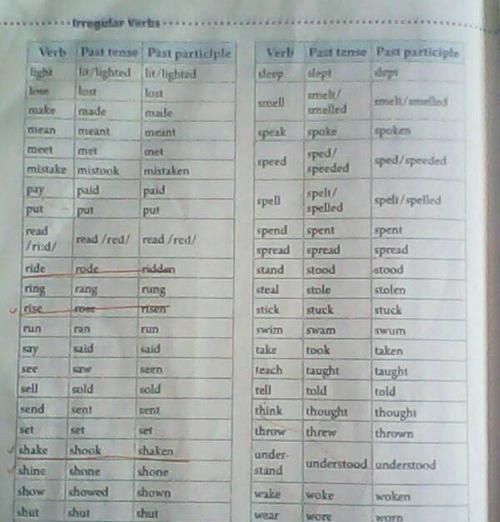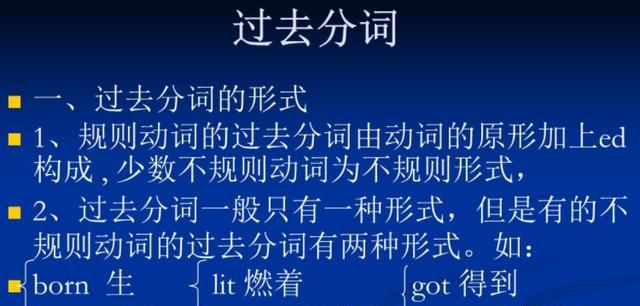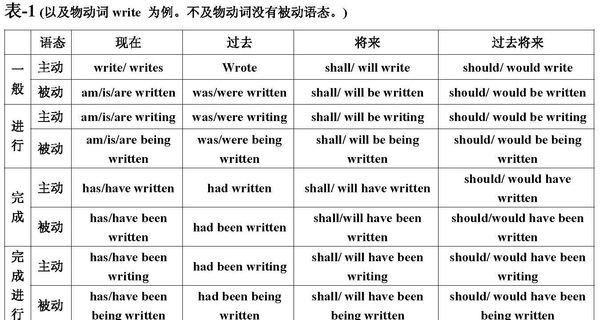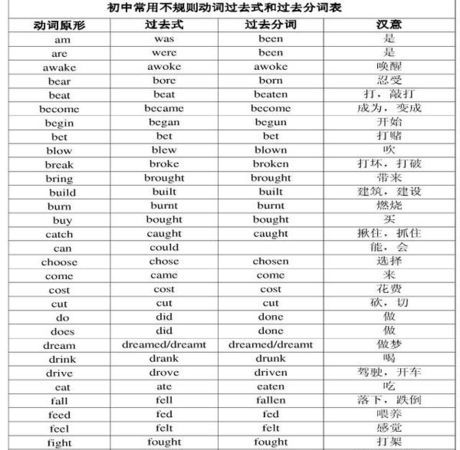本文目录
过去分词可以表被动吗
英语中有一种"get+过去分词"构成的被动语态.其中get与"be+过去分词"结构中的be同样起助动词的作用.这种结构在谈论突然发生、出乎意料的偶然事件.
【例如】It is upsetting when a person gets punished for a crime that he didn’t commit.The picture got damaged (=was damaged) when we were moving.If they make such criticisms they will get treated with the contempt they deserve.The old lady got hit by a flower pot falling from a balcony.I got invited to lots of parties last holidays.I don’t want to get mixed up with the police again.
"get+过去分词"与"be+过去分词"表达的被动语态并不完全相同,"be+过去分词"既可表示动作,又可表示状态,而"get+过去分词"则主要表示动作【例如】The police say the man was shot when they found him,but they don’t know when he got shot.
在这个句子中was shot表示状态,而got shot则表示动作.再如:另外,"be+过去分词"构成的被动语态不用于将来进行时和完成进行时;而"get+过去分词"可以用这些时态.

过去分词表被动和被动语态有什么区别
规则动词的过去分词一般是由动词加ed构成(具体规则见后),不规则动词的过去分词见不规则动词表。
过去分词则属于类动词:
1.
及物动词的过去分词作表语,与句子的主语是被动关系,表示主语的状态,不但表示被动,还表示已完成了.
The
cup
is
broken.
茶杯破了.
2.
不及物动词的过去分词作表语,与句子的主语是主动关系,表示主语的状态,只表示动作的完成.
He
is
retired.
他已退休.
3.
有些过去分词作表语时,构成的谓语很接近被动结构.
构成:主语+have/has+动词的过去分词(done)
1
、规则
词:规则动词的过去分词的构成规则与规则动词的过去式的构成规则相同。四点变化规则:
(1)、一般动词,在词尾直接加“
ed
”。(然而要注意的是,过去分词并不是过去式)
work---worked---worked
,visit---visited---visited
(2)、以“
e
”结尾的动词,只在词尾加“
d
”。
live---lived---lived
,
(3)、以“辅音字母
+
y
”结尾的动词,将
"y"
变为
"i"
,再加“
ed
”。
study---studied---studied
,cry---cried---cried
,
(4)、重读闭音节结尾,末尾只有一个辅音字母,先双写该辅音字母,再加“
ed
”。
stop---stopped---stopped
,
drop---dropped--dropped
2
、不规则动词,见不规则表

什么时候用过去分词表被动
是的。
去分词与现在分词被动式的区别
(1)过去分词在构成完成时态,不定式完成式以及被动语态时,通常不能用现在分词一般被动式代替。(现在进行时的被动语态除外)
eg:The door was closed an hour ago.
这门在一小时前就关闭了。
They have finished their homework。
他们已经做完了家庭作业
(2)过去分词作前置定语时,不能用现在分词一般被动式代替。
eg: That was an inspired suggestion.
那是一条由某人提出的建议。
同样现在分词一般被动式作为定语表示动作时,也不能用过去分词来代替。
eg:The house being built is a big project.
正在施工的那幢楼是一项大的工程。
(3)过去分词作条件、时间等状语时,不可用现在分词一般被动式代替。
eg:Given more time,I can do it better.(表条件)'
多给点时间,我会做得更好些。
Given more attention,the trees could have grown better.(表示条件)
如果多关心一些,这些树会长得更好。
Heated ,the metal expands.(表示时间)
加热后,这种金属会膨胀。
Asked why he did it,he said it was his duty .(表示时间)
问及为何要做此事时,他说这是他的职责。
(4)过去分词作表语时,不能用现在分词一般被动式代替。
eg:The top of the mountain is covered with snow .山顶满是雪。
(5)过去分词在构成have,get,want等动词后的复合宾语时,不能用现在分词一般被动式。
eg:Why don’t you have the radio fixed?
你为什么不把收音机拿去修一修?
尤其是一些感官动词,如:see,hear,find等后构成复合宾语时,过去分词和现在分词一般被动式意思完全不同。
eg:I heard this song being sung by my students in the next room.
我听到隔壁房间的学生正在吟唱这首歌。
(注:现在分词一般被动式表示正在进行的动作)
I have never heard this song sung in English.
我从来没有听到过用英语唱这首歌。
(注:过去分词表示己完成的动作)
(6)在下面一些比较固定的分词独立结构中,通常多用过去分词。
eg: all told总计
all things considered考虑了一切因素之后
this accomplished完成这项工程之后
this explantion given这样解释之后
all said and done毕竟
二.过去分词和现在分词完成被动式的区别:
及物动词的过去分词没有完成式,但它有“完成”的含义,所以它可以代替现在分词完成被动式。
eg:The bridge had been weakened by successive storms and was no longer safe .
Weakened by successive storms,the bridge was no longer safe.
Having been weakened by successive storms,the bridge was no longer safe.
这座桥接二连三地遭到暴风雨的袭击后,己经不安全了。
但若强调分词表示的行为发生在后一个动词表示的行为之前时,可用现在分词完成被动式。
eg:Having been warned about the bandits,he left his valuables at home。
当警告有强盗出没时,他就把贵重物品留在家里。
通常过去分词可作定语使用,而现在分词完成被动式却不能用作定语。
eg:The computer centre,opened last year,is very popular among the students in this school.
去年开办的计算机中心很受学生的欢迎。
(过去分词既能表示被动又有完成的含义)

什么时候用过去分词什么时候用被动语态
过去分词是动词的一种形式,可以用来表示被动语态和现在/过去完成时,当过去分词前面是be动词的某种形式时,那一定是被动语态;当过去分词前面是have/has/had时,那一定是完成时态。
e.g.
The
floor
is
cleaned.
(这是被动,因为cleaned前面是is,
be动词的一种形式。)
He
has
cleaned
the
floor.
(这是完成时,因为cleaned前面是has.)
在上述两个例句中,同样是过去分词cleaned,因为前面的助词不同,所以二者表达的意思也不同,一个表被动,一个表完成时。
祝好运。

以上就是关于过去分词可以表示被动,过去分词可以表被动吗的全部内容,以及过去分词可以表示被动吗 的相关内容,希望能够帮到您。

